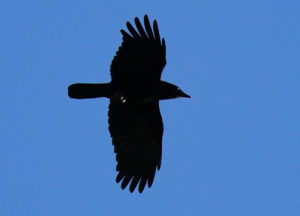Dave Strauss writes in with a question about this rather tall jay: “I have often seen and photographed western scrub-jays, but this one seems to have odd proportions. The head and neck appear large compared to the body. Does this look like normal variation, or does it appear to be unusual for some other reason? I thought it might be a hybrid bird.”
Good eye for unusual posture, Dave!
My first thought was: Now that’s an alert bird! Probably this animal is stretching itself out vertically to get a better overhead view of some potential invertebrate lunch on the ground.
I checked with David Herlocker, of the Marin County Open Space District, one of our region’s best all-around naturalists. He confirmed my hunch: “I think your assumption is spot on – just an alert posture. I think scrub-jays can look positively human sometimes, something about the proportion of the head size and the neck (when extended like this). Of course, they’re corvids which means they are smarter than we are, so it’s easy to imagine some articulate internal dialogue going on in there.”
Bay Nature Facebook fan Joseph Martin also pointed out a tinge of gray on the bird’s wing — some lingering down, perhaps? If so, it could be a juvenile that hasn’t quite grown filled out into full adult proportions.
In any case, the intelligence of corvids (crows and jays and relations) comes up now and then in our work here. Our next issue has a feature on Butano State Park, where scientist Portia Halbert has been leading a couple of efforts to trick crows and especially Steller’s jays into not eating the eggs of endangered marbled murrelets, and convincing us not to leave food scraps that make the crows and jays more likely to stick around the forest.
On a more positive note, back in 2007, Judith Larner Lowry wrote a delightful feature for us on the Landscaping Ideas of Jays. Jays eat acorns but, more importantly, they stash them away for later. You can visit the new Oakland Museum science gallery and see a column of acorns — more than 4,000 of them — that represent a year’s caching of one bird. These bird’s have such remarkable memories for their caches that a scholar at UC Davis has set up extensive lab experiments to test them (we interviewed him in our 2007 piece “Finding the Stash“). But jays aren’t infallible, and that’s good for oaks. Some of the forgotten acorns go on to become trees. And that’s one way oaks spread across the landscape.
So next time you’re in an oak woodland, thank a jay. And next time you’re in the redwoods, be sure to pack out all your leftovers.





.jpg)